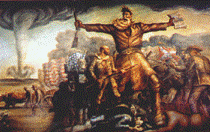History, Department of

James A. Rawley Graduate Conference in the Humanities
Date of this Version
April 2008
Document Type
Article
Abstract
The “Red Summer of 1919” marked the nadir of interracial violence that characterized urban America during the post-World War I era. Of the more than twenty-five cities that experienced so-called “race riots” that year, Omaha, Nebraska on 28 September 1919 witnessed a vigilante mob of white youth and adults numbering in the thousands destroy the county courthouse, attempt to lynch Omaha’s mayor, and brutally execute an African American man named William Brown. The violence in Omaha and places as disparate as Chicago, Washington, D.C., and Longview, Texas occurred in communities coping with dramatic internal migrations, urban spatial tension, job competition, wartime xenophobia, and popularized fears of interracial sex.
This paper suggests that those factors, although significant, were not the primary impetuses for the white uprising in Omaha. This paper argues that throughout 1919 Omaha’s newspapers meticulously sensationalized alleged sexual assaults by African American men in and outside of Omaha. Yet also intertwined were Omaha’s machine politics and a recently-ousted political boss vying to discredit a newly elected progressive mayor through the pages of the Omaha Daily Bee. Utilizing newspaper articles, diaries, and interview transcripts, this paper examines how Omaha newspapers sensationalized mob violence and alleged sexual assaults committed by African Americans in order to weaken Omaha’s mayor. This paper finds that the newspapers had a profound impact on exacerbating white perceptions about Omaha’s African American community.


Comments
Paper presented at the 3rd Annual James A. Rawley Conference in the Humanities — Imagining Communities: People, Places, Meanings. Lincoln, Nebraska, April 12, 2008. Sponsored by the University of Nebraska–Lincoln History Graduate Students’ Association. Copyright © 2008 Nicholas Swiercek.